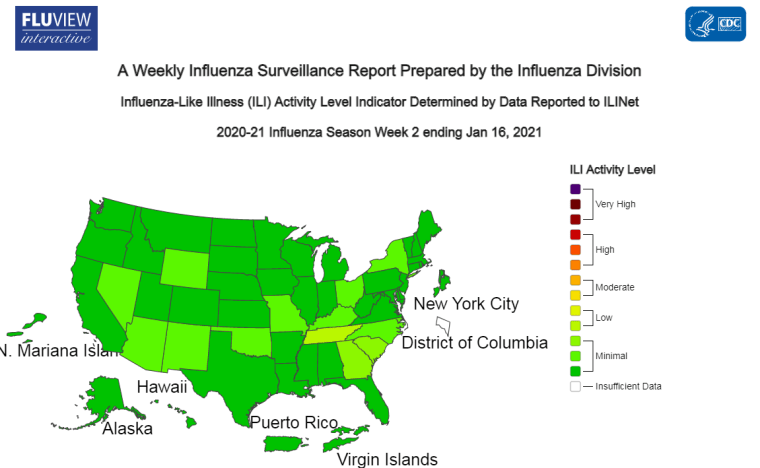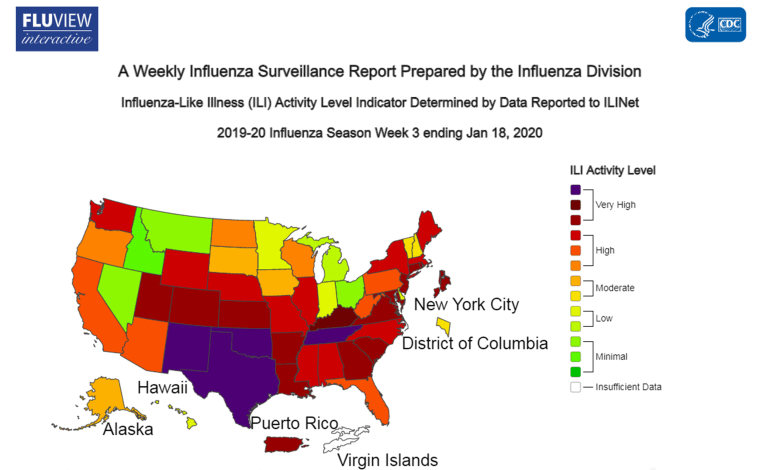As the world focuses on COVID-19, influenza — that other contagious respiratory illness caused by a virus — seems to have all but disappeared.
Flu activity is “unusually low” for this time of year, the Centers for Disease Control and Prevention said in its latest weekly U.S. influenza surveillance report.
“The CDC is being modest — influenza is at record-setting lows,” Dr. William Schaffner, professor of infectious diseases at Vanderbilt University School of Medicine in Nashville, Tennessee, told TODAY.
“The flu virus is not circulating in our population the way it normally does.”
He and his colleagues have been conducting flu surveillance since the 1990s and have never seen illness levels close to this low, Schaffner noted.
Flu activity is “significantly down,” added Dr. Nisa Maruthur, a primary care physician and associate professor of medicine at Johns Hopkins University in Baltimore.
Some 136 people were hospitalized for the flu between Oct. 1, 2020, and Jan. 16, 2021, and there were 292 deaths involving influenza during that period, the CDC reported. One child has died.
The flu season is far from over — it usually begins in the fall, and peaks between December and February.
But in comparison, 400,000 people were hospitalized for the flu and 22,000 died, including 434 children, during the entire 2019–2020 season, which the CDC described as “severe” for kids 4 years old and younger, and for adults 18-49 years old.
The flu activity maps look very different for the same week in January 2020, compared to 2021, with most states reporting minimal activity this year:

In 2020, high or very high flu activity dominated the map:

The change is not surprising since the flu virus spreads through respiratory droplets, similar to the new coronavirus, and people are wearing masks, social distancing and paying attention to hand hygiene to avoid COVID-19, said Dr. Waleed Javaid, director of infection prevention and control at Mount Sinai Downtown in New York.
“Fewer people are out and about, and people are even hopefully less likely to be out if they are symptomatic,” Maruthur added. “In normal years, people who are symptomatic do not typically feel the same need to stay home.”
But the major contributor has to do with children, who are usually “the great distribution engine” for the flu, Schaffner noted. Kids are very contagious because they make more influenza virus than adults and they shed it for longer periods of time.
But during the coronavirus epidemic, many children are either learning from home, or wearing masks and social distancing at school.
“Children are not getting infected and not bringing the virus home to their elders,” Schaffner said.
It’s the reason he thinks the incredibly low flu activity during the coronavirus crisis won’t be repeated in the years to come.
Still, mask-wearing could outlast the epidemic, especially since it has become familiar to people in the last year, Javaid said
“Would it be a best practice in winter seasons to wear a mask? I am inclined to say yes,” he noted. “I think we should seriously consider using masks to reduce the intensity of flu seasons.”
That could lessen flu hospitalizations and deaths in years to come, but there won’t be an impact if only a few Americans keep wearing masks and social distancing in future flu seasons, the experts said.
Some people are already declaring they’ll keep the mask habit given that they haven’t had the sniffles or any other cold and flu symptoms since the coronavirus started.
Other lessons learned are that physical distancing, getting the flu shot and staying home if you are symptomatic are also very effective, Maruthur added. More than 193 million doses of flu vaccine have been distributed as of mid-January, the CDC said.
“We're all used to seeing people wear masks now — no big deal. I think we may see much more of that and more cautious behavior during influenza season,” Schaffner noted.
“Wear your masks, social distance — do those sorts of things on an annual basis. I think we'll see much more of that messaging because it's now more socially acceptable and familiar to many people.”
Does a lighter-than-normal flu season so far this year mean the next one will be more problematic? Flu is "very quirky" so there's no way to predict what will happen in 2022, said NBC News medical correspondent Dr. John Torres. The main message is to get a flu shot in the fall, and still get one now if you haven't already in case flu activity picks up in the coming weeks.


